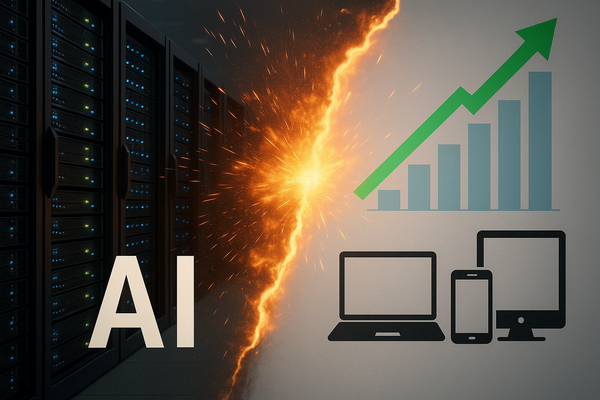
Markets are balancing two powerful forces this week: a massive acceleration in AI infrastructure spending that is reshaping capital allocation across semiconductors, cloud providers and systems integrators, and a flicker of resilient consumer demand that shows up most clearly at Apple. Together these dynamics are driving fresh re-ratings, analyst updates and dealmaking across the technology universe.
The AI infrastructure buildout: numbers that matter
The scale of the AI data‑center wave is now explicit. Nvidia announced plans to invest as much as $100 billion in OpenAI to support an enormous data‑center expansion, and the broader Stargate initiative led by OpenAI, Oracle and SoftBank has so far committed up to $500 billion to build nearly 10 gigawatts of new capacity. Oracle itself is described as securing a multiyear cloud commitment valued at roughly $300 billion over five years, positioning the company as a major infrastructure beneficiary.
Those headline commitments are rippling through the supply chain. Memory vendor Micron reported fiscal Q4 revenue of $11.32 billion and adjusted EPS of $3.03 — with GAAP profit per share of $2.83 — and guided to sequential strength, forecasting about $1.2 billion of sequential revenue growth and gross margins exceeding 50%. That performance and guidance underscore how demand for high‑bandwidth memory (HBM) and DRAM is being pulled forward by AI training and inference workloads.
How the market is reacting: winners, rotations and analyst moves
Semiconductor and infrastructure names have been the primary beneficiaries: Nvidia and its ecosystem partners posted multiple positive analyst notes; Micron beat consensus and raised outlook; Broadcom and other infrastructure suppliers saw active coverage and upward repricing. NVDA and MSFT together appear repeatedly in market headlines — NVDA for its investment and ecosystem role, and Microsoft for large data‑center investments such as the announced $7 billion commitment in Wisconsin.
Oracle and other cloud providers are being re‑seen as hyperscalers: Oracle’s expanded role in Stargate and large cloud agreements are generating fresh narratives about its ability to capture enterprise and sovereign AI workloads. Snowflake and several partners launched the Open Semantic Interchange initiative to standardize metadata and improve AI readiness — a sign that software and data platforms are racing to capture value beyond raw compute.
Consumer tech and hardware: Apple’s counterpoint
While datacenter capex headlines dominate, consumer demand remains relevant. Apple’s product cycle produced a tangible market response: coverage notes that demand for the iPhone 17 family — including the new iPhone Air at a price point reported at $999 — helped lift the shares back into year‑to‑date positive territory for 2025. Broker activity followed: Wedbush raised a target to $310 citing strong iPhone 17 demand, and other analysts reiterated bullish views on the smartphone upgrade cycle.
Apple also had a flurry of operational and retail updates: the reopening of Apple Ginza on September 26, 2025; third‑party payment/platform integrations such as Tap to Pay on iPhone being supported by providers like Fortis; and continued press and analyst commentary around the company’s AI strategy and hardware durability testing. Collectively these items signal that while enterprise AI is changing the capital stack, consumer hardware — led by Apple — still moves cash flow and investor sentiment.
Across both camps, volatility has appeared in intraday sessions as the market weighs the long horizon of AI spending against nearer‑term monetary and valuation considerations. Jerome Powell’s public comments about the economy and Fed positioning added caution to a tape that had been chasing record highs propelled by AI bets.
- Actionable takeaway 1: If you favor exposure to the AI infrastructure buildout, prioritize high‑bandwidth memory and data‑center systems suppliers that reported concrete benefit from AI demand (example: Micron: $11.32B revenue; adjusted EPS $3.03; guided ~$1.2B sequential revenue growth).
- Actionable takeaway 2: For diversified tech exposure, balance hyperscaler/cloud names that are winning large AI contracts (Oracle, Microsoft) with software and data platform plays (Snowflake, Salesforce partners) that are standardizing AI data semantics through initiatives like the Open Semantic Interchange.
In short, the market is parsing two parallel narratives: the long‑term structural reallocation to AI infrastructure with multi‑hundred‑billion dollar commitments, and a still‑meaningful consumer cycle reflected at Apple. Risk management should account for both: the pull of multi‑year capital programs for AI, and near‑term sensitivity to macro comments and product cycle news.
Investors tracking this space will want to watch sequential revenue guides and contract announcements from memory, silicon and cloud vendors, and monitor consumer upgrade signals and margin trends at hardware incumbents. The coming quarters should make clearer who captures the long tail of AI spending versus who benefits from near‑term device demand.












